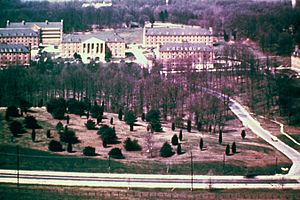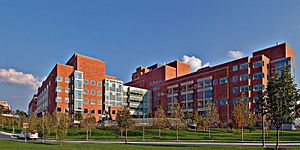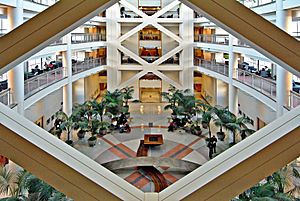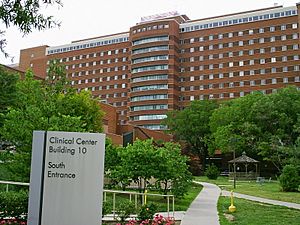National Institutes of Health facts for kids

Logo
|
|
 Aerial photo of the NIH Mark O. Hatfield Clinical Research Center in Bethesda, Maryland |
|
| Agency overview | |
|---|---|
| Formed | August 1887 |
| Preceding agency |
|
| Headquarters | Bethesda, Maryland, U.S. 39°00′09″N 77°06′16″W / 39.00250°N 77.10444°W |
| Employees | 18,478 (2021), [1] |
| Annual budget | $45 billion (2022) |
| Agency executive |
|
| Parent agency | Department of Health & Human Services |
| Child agencies |
|
The National Institutes of Health, or NIH, is a main part of the U.S. government. It focuses on biomedical and public health research. This means they study health and diseases to help people.
NIH started in the late 1880s. Today, it is part of the United States Department of Health and Human Services. Many NIH buildings are in Bethesda, Maryland. Other facilities are in North Carolina and across the U.S.
NIH does its own science research. This is called the NIH Intramural Research Program (IRP). They also give money to other research groups. This is called the Extramural Research Program. In 2003, NIH provided about 28% of all U.S. biomedical research funding.
The NIH has 27 different institutes and centers. Each one focuses on a specific area of health. NIH has helped with many important discoveries. These include finding fluoride to stop tooth decay. They also helped create vaccines for diseases like hepatitis and HPV.
In 2019, NIH was ranked second in the world for biomedical sciences. This shows how important their research is.
Contents
Discovering Health: The History of NIH
Early Beginnings: Hygienic Laboratory
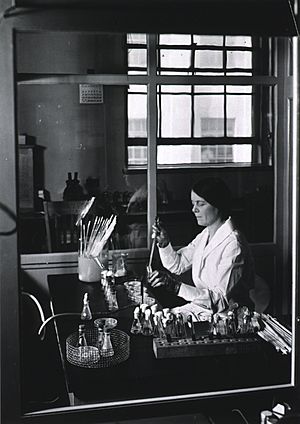
The story of NIH began in 1887. A small lab was created to study bacteria. It was called the Hygienic Laboratory. This lab was part of the Marine Hospital Service. This service was growing beyond just hospitals. It started to include research.
The lab first opened in Staten Island, New York. In 1891, it moved to Washington, D.C.. By 1904, it had moved again to a new campus. This campus grew to have five large buildings.
In 1901, the Division of Scientific Research was formed. The Hygienic Laboratory was part of this new division. In 1912, the Marine Hospital Service became the Public Health Service (PHS). The PHS started working with universities in 1922. They opened a cancer research lab at Harvard Medical School.
Becoming the National Institute of Health
In 1930, the Hygienic Laboratory got a new name. It became the National Institute of Health. This change happened because of the Ransdell Act. The act also gave $750,000 to build new labs. In 1937, the National Institute of Health took over the rest of the Division of Scientific Research.
In 1938, NIH moved to its current home. This is the main campus in Bethesda, Maryland. Over the next few years, Congress gave NIH much more money. New institutes and centers were created for different research areas. In 1944, the Public Health Service Act was passed. The National Cancer Institute became part of NIH. In 1948, the name changed again. It became the National Institutes of Health (plural).
Later Developments and Research Focus
In the 1960s, a researcher named Chester M. Southam did some experiments. He injected cancer cells into patients. Some doctors refused to do this without patient permission. The NIH found that many research groups were not protecting people's rights. After this, NIH made new rules. All research involving people must get their permission first.
In 1967, a new division was created. It gave money for research on heart disease, cancer, and strokes. The NIH director asked for more government money. He wanted to speed up health benefits for everyone. By 1971, cancer research was a big focus. President Nixon signed the National Cancer Act. This started a national program to fight cancer.
Funding for NIH has often been a topic of discussion in Congress. In the 1990s, NIH's budget nearly tripled. It has stayed about the same since then. By the 1990s, NIH started focusing on DNA research. They launched the Human Genome Project. This project aimed to map all human genes.
Leading the Way: How NIH Works
NIH Leadership and Structure
The Office of the Director is the main office at NIH. It sets the rules for NIH. It also plans and manages all the programs. The NIH Director guides the different institutes and centers. They find new research needs and opportunities.
Inside the Director's Office is a special division. It is called the Division of Program Coordination, Planning, and Strategic Initiatives. It has many important offices, including:
- Office of AIDS Research
- Office of Research on Women's Health
- Office of Disease Prevention
- Tribal Health Research Office
There are also offices that make sure research is done correctly. The Agency Intramural Research Integrity Officer checks research inside NIH. The Division of Extramural Activities manages grants for outside researchers.
Where NIH Research Happens
Most of NIH's own research is done at the main campus. This is in Bethesda, Maryland. Other research happens in Rockville, Maryland.
The Bayview Campus in Baltimore, Maryland, has research programs. These include the National Institute on Aging. The Frederick National Laboratory in Frederick, MD, also hosts many parts of the National Cancer Institute.
The National Institute of Environmental Health Sciences is in North Carolina. Other institutes have smaller locations too. For example, the National Institute of Allergy and Infectious Diseases has labs in Hamilton, Montana.
Breakthroughs and Discoveries at NIH
NIH-supported scientists have won many awards. As of 2017, 153 scientists with NIH funding won a Nobel Prize. Many others won a Lasker Award.
Research Inside and Outside NIH
NIH uses about 10% of its money for research within its own labs. This is called intramural research. More than 80% of its money goes to outside researchers. This is done through research grants. These grants go to scientists at universities and other places.
In 2011, NIH gave about 50,000 grants. These went to over 325,000 researchers. They worked at more than 3000 different places. By 2018, this number was still high.
Sharing Research with Everyone
In 2008, Congress made a rule. Scientists funded by NIH must share their research papers. They have to send them to PubMed Central (PMC). This is a research library run by the National Library of Medicine. Papers must be available within 12 months. This was the first rule of its kind in the U.S.
Impact of NIH Research
NIH research helps the economy. In 2000, a report said NIH research saves money. It reduces the cost of illness in the U.S. NIH-funded research has helped discover many new drugs and vaccines. From 2010 to 2016, NIH funding helped develop all 210 FDA-approved drugs.
Important Discoveries and Developments
NIH's own research has led to many key medical breakthroughs:
- 1908: Discovery that rodents carry bubonic plague.
- 1924: A vaccine was developed for Rocky Mountain spotted fever.
- 1930: A treatment for mercury poisoning was created.
- 1943: New ways to grow cells in the lab were pioneered.
- 1950s: Discovery of enzymes important for how drugs work in the body.
- 1960s: Found the cause of kuru, a brain disease. This changed how we think about infections.
- 1960s: Developed the first rubella vaccine.
- 1960s: Found that bacteria cause tooth decay.
- 1970s: Developed the test used in home pregnancy kits.
- 1990s: The first human gene therapy trial took place.
NIH Toolbox for Health Studies
In 2006, NIH started the NIH Toolbox project. It created modern tools to measure brain and behavior functions. These tools help collect data in large health studies. Scientists from over 100 places helped create it. The NIH Toolbox became available to researchers in 2012.
Database of Genetic Information
NIH also supports the Database of Genotypes and Phenotypes (dbGaP). This is a collection of information. It shows how genes (genotypes) affect traits (phenotypes). Researchers can access this detailed information.
In 2020, NIH worked with Moderna. They developed a mRNA-1273 vaccine for COVID-19. Testing began with 30,000 volunteers. In 2021, NIH also helped fund the ACTIV program. This program speeds up COVID-19 treatments and vaccines.
Pain Research Coordination
In 2012, NIH announced a new group. It is called the NIH Interagency Pain Research Coordinating Committee. This group brings together researchers from different organizations. Their goal is to work together on pain research. This helps increase knowledge about pain management.
Funding Health Research
NIH Budget and How it's Decided
| Year | Budget (millions) |
|---|---|
| 1938 | 0.5 |
| 1940 | 0.7 |
| 1945 | 2.8 |
| 1950 | 52.7 |
| 1955 | 81.2 |
| 1960 | 399.4 |
| 1965 | 959.2 |
| 1970 | 1,061.0 |
| 1975 | 2,092.9 |
| 1980 | 3,428.9 |
| 1985 | 5,149.5 |
| 1990 | 7,567.4 |
| 1995 | 11,299.5 |
| 2000 | 17,840.5 |
| 2005 | 28,594.4 |
| 2010 | 31,238.0 |
| 2015 | 30,311.4 |
| 2016 | 32,311.4 |
| 2017 | 34,300.9 |
| 2018 | 37,311.3 |
| 2019 | 39,311.3 |
| 2020 | 41,690.0 |
| 2021 | 42,940.5 |
| 2022 | 45,183.0 |
| 2023 | 47,683.5 |
To get money, NIH first asks Congress for a budget. Leaders from each institute work with scientists. They decide which research areas are most important. Then, NIH management creates a budget request. This request includes money for ongoing projects and new ideas.
NIH sends its request to the Department of Health and Human Services (HHS). HHS then sends it to the Office of Management and Budget (OMB). OMB decides what amounts are approved for the President's budget. The President then sends this budget to Congress.
Congress then discusses and approves the funding. This whole process can take about 18 months. If the government shuts down, NIH still treats patients already in clinical trials. But they don't start new trials or accept new patients, unless it's an emergency.
How Funding Has Changed
Over time, Congress has started to set aside money for specific causes. In the 1970s, money was set aside for cancer research. In the 1980s, a lot of money went to AIDS/HIV research.
Funding for NIH has often been a topic of discussion in Congress. In the 1980s, President Reagan tried to cut funding. But Congress often restored some of it. The debate over funding slowed the nation's response to the AIDS epidemic.
In 1992, NIH's budget was almost 1% of the government's spending. It controlled over 50% of all health research funding. From 1993 to 2001, the NIH budget doubled. After that, funding stayed about the same for several years. In 2017 and 2018, Congress greatly increased NIH's funding.
Grants for Outside Researchers
Researchers at universities can apply for research project grants (RPGs) from NIH. There are different types of grants. They support various projects and career stages. NIH often asks for applications for specific health problems. Researchers can also apply for grants for their own ideas.
The number of scientists applying for grants has grown. From 1999 to 2003, about 60,000 applied. From 2011 to 2015, nearly 90,000 applied. This means it's harder to get funded.
R01 grants are the most common type. They are for projects started by scientists. From 2012 to 2014, about 17-19% of R01 applications received funding. In 2016, NIH received over 54,000 grant applications. About 19% of them received funding.
How Funding Decisions Are Made
NIH uses five main rules to decide on funding:
- 1. Fund the best science through a careful review process.
- 2. Choose projects that can lead to new knowledge. These should help prevent and treat diseases.
- 3. Support many different types of research. This includes cell biology, genetics, and engineering.
- 4. Address public health needs. They look at how common and deadly diseases are.
- 5. Build and support good scientific labs and facilities.
Advisory committee members help guide the institutes. They review all grant applications.
Fairness in Research Funding
In 2014, NIH made a new rule. Scientists must include both female and male animals in their studies. This also applies to cells from females and males. NIH checks this when giving out grants. This rule might not apply to diseases that only affect one sex.
Who Benefits from NIH Funding?
The Public
One goal of NIH is to expand medical science. This ensures a good return on public money spent on research. Taxpayers fund NIH, so they are the main beneficiaries. They gain from advances in health research. Some people feel their interests are not fully represented. So, they form groups to speak for them.
Researchers and Scientists
Researchers and scientists are key people affected by NIH funding. Outside researchers are not employed by NIH. But they can apply for funding. The amount of funding has increased over time. Each institute decides who gets the grant money.
Changes in funding rules affect researchers. For example, NIH has tried to fund more first-time applicants. They also want to fund young scientists. The application process has been made simpler for them. First-time applicants may also get more money for their research.
NIH Institutes and Centers
The NIH has 27 separate institutes and centers. They all conduct and coordinate biomedical research. These include:
- National Cancer Institute (NCI)
- National Eye Institute (NEI)
- National Heart, Lung, and Blood Institute (NHLBI)
- National Human Genome Research Institute (NHGRI)
- National Institute on Aging (NIA)
- National Institute on Alcohol Abuse and Alcoholism (NIAAA)
- National Institute of Allergy and Infectious Diseases (NIAID)
- National Institute of Arthritis and Musculoskeletal and Skin Diseases (NIAMS)
- National Institute of Biomedical Imaging and Bioengineering (NIBIB)
- National Institute of Child Health and Human Development (NICHD)
- National Institute on Deafness and Other Communication Disorders (NIDCD)
- National Institute of Dental and Craniofacial Research (NIDCR)
- National Institute of Diabetes and Digestive and Kidney Diseases (NIDDK)
- National Institute on Drug Abuse (NIDA)
- National Institute of Environmental Health Sciences (NIEHS)
- National Institute of General Medical Sciences (NIGMS)
- National Institute of Mental Health (NIMH)
- National Institute on Minority Health and Health Disparities (NIMHD)
- National Institute of Neurological Disorders and Stroke (NINDS)
- National Institute of Nursing Research (NINR)
- National Library of Medicine (NLM)
- Center for Information Technology (CIT)
- Center for Scientific Review (CSR)
- Fogarty International Center (FIC)
- National Center for Advancing Translational Sciences (NCATS)
- National Center for Complementary and Integrative Health (NCCIH)
- NIH Clinical Center (NIH CC)
New Health Research Agency: ARPA-H
The Advanced Research Projects Agency for Health (ARPA-H) is a new group. Congress created it in 2022. It is designed to find new and unusual research projects. It works differently from typical government agencies. In 2022, it received $1 billion. It is asking for $2.5 billion for 2024.
Past Leaders of NIH
Source:
| Portrait | Directors | Took office | Left office |
|---|---|---|---|
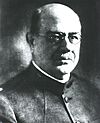 |
Joseph J. Kinyoun | August 1887 | April 30, 1899 |
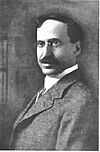 |
Milton J. Rosenau | May 1, 1899 | September 30, 1909 |
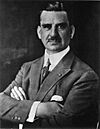 |
John F. Anderson | October 1, 1909 | November 19, 1915 |
 |
George W. McCoy | November 20, 1915 | January 31, 1937 |
 |
Lewis Ryers Thompson | February 1, 1937 | January 31, 1942 |
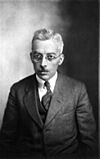 |
Rolla Dyer | February 1, 1942 | September 30, 1950 |
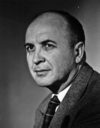 |
William H. Sebrell Jr. | October 1, 1950 | July 31, 1955 |
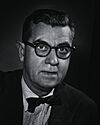 |
James A. Shannon | August 1, 1955 | August 31, 1968 |
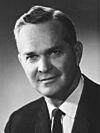 |
Robert Q. Marston | September 1, 1968 | January 21, 1973 |
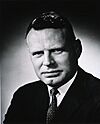 |
John F. Sherman (acting) | January 21, 1973 | May 28, 1973 |
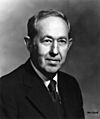 |
Robert Stone | May 29, 1973 | January 31, 1975 |
 |
Ronald W. Lamont-Havers (acting) | February 1, 1975 | June 30, 1975 |
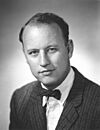 |
Donald S. Fredrickson | July 1, 1975 | June 30, 1981 |
 |
Thomas E. Malone | July 1, 1981 | April 28, 1982 |
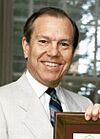 |
James Wyngaarden | April 29, 1982 | July 31, 1989 |
 |
William F. Raub (acting) | August 1, 1989 | April 8, 1991 |
 |
Bernadine Healy | April 9, 1991 | July 30, 1993 |
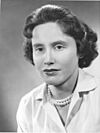 |
Ruth L. Kirschstein (acting) | July 1, 1993 | November 22, 1993 |
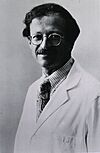 |
Harold E. Varmus | November 23, 1993 | December 31, 1999 |
 |
Ruth L. Kirschstein (acting) | January 1, 2000 | May 2, 2002 |
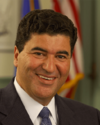 |
Elias Zerhouni | May 2, 2002 | October 31, 2008 |
 |
Raynard S. Kington (acting) | October 31, 2008 | August 16, 2009 |
 |
Francis S. Collins | August 17, 2009 | December 19, 2021 |
 |
Lawrence A. Tabak (acting) | December 20, 2021 | November 8, 2023 |
 |
Monica Bertagnolli | November 9, 2023 | Present |
See also
 In Spanish: Institutos Nacionales de Salud para niños
In Spanish: Institutos Nacionales de Salud para niños
- List of institutes and centers of the National Institutes of Health
- United States Public Health Service
- Foundation for the National Institutes of Health
- National Institutes of Health Stroke Scale
- Heads of International Research Organizations
- NIH Toolbox
- National Institute of Food and Agriculture
- Biomedical Engineering and Instrumentation Program (BEIP)


